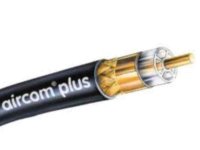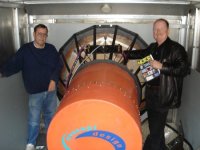Mine takes just under 10 seconds to develop full power. Way back (40+ years) when microwave oven leakage energy was a concern I built meter to look at it.
The meter was a 1N21 diode and a 50 uA meter. Easily measured leakage. Dirt on the door seals raised it to almost double the normal reading. But that is when I learned there is a turn on delay.
So if you worry about such things, be sure your door seals are clean.
Ed, What else did you have attached to the meter? or was the diode just attached to it? Which way? Just in series ? and plugged into the meter/ attached to it?
I already told the wife that none of these devices are allowed in the house unless they talk like Paul Lynde.
That made me laugh out loud.
(Sorry, I can't bring myself to type "LOL," even ironically.)
My humidity at this very moment is 26%. A bit low my target is 30%. So a small adjustment is needed.
No I haven't personally seen the Micosoft one but what I have seen near there is quite interesting and under an NDA.
Dan, Bill it seems I need your shipping addresses. Also it is begining to look like you may need a large box.
How does it compare to ElectroVoice chamber?
John, do you have a link to that 1973 article?
Wouldn't it be nice to have a depository of articles right here on DIY?
So when I went back to school thinking great, I can use the library
for research. What was I thinking? When I asked about it they
said, NO, it's too expensive, you have to go to a University for that.
Last edited:
Here is the article:
*Transient lntermodulation
Distortion This type of distortion occurring at nonstationary signals, is caused by the feedback
Again with Otala.

Ed, What else did you have attached to the meter? or was the diode just attached to it? Which way? Just in series ? and plugged into the meter/ attached to it?
At those frequencies the wavelength is about 12 cm. All you have to do is connect the diode to the meter with two pieces of wire 6 cm. long.
Never looked at EV's chamber.
When I measure the noise level at home I have to hold my breath, that at times is the noisiest thing in the room. But I will admit the level does rise when a train goes by. My noise leakage is due to the windows only being double pane. The noise level is low because normal background noise is actually lowest in small towns. Cities obviously have too many noise sources. Way out in the country insect noises dominate. Small towns are actually the quietest. Usually under 45 dBa. So it is not that hard to get decently quiet.
Bill note spelling of dBa. "A" is weighting scale, "a" is reference to ambient.
Here is a thought-
The capacitance will cause increased current to drive it in the output circuits. You could measure the drain current at a low frequency (10Hz) in the output circuit. Raise the frequency to something like 10 KHz and see how much in increases. Add a known cap to ground and see how much it increases. The increase in current with frequency will be the capacitance plus some other small factors I would think.
That was a good tip! I did measure the rms drive current into the Vas source as that is easy to do. This is equivalent to measuring the output current.
At very low frequency, Vout and Iout work out to just a tad over 2Meg. With a feedback R of 2.4Meg and a probe hanging off the output, that seems pretty OK.
At 20kHz the output current of course rose fast and the equivalent load came to about 185k, which is the parallel impedance of that 2Meg and the cap load.
Cap load then works out to 43pF. Since LTspice told me 45pF and my calculations said 50pF max, seems like a good result.
Only one thing bothers me: if I hang an extra 56pF on the output, the output current does not double, only rises 25% or so; this needs investigating...
Anyway Demian you made my Sunday!
Jan
100pF/m for RG213U is more that I might consider sensible for speaker runs unless I was very sure of the amplifier stability. 2.25mm2 centre conductor would of course horrify the meaty hosepipe school of speaker cable as well
I have once have bought 100 meters of Aircom Plus cable, that is maybe slightly
thicker than RG213 and the center conductor is supported only by a PE star,
most of the dielectric is air. The clerk carried it to the cash register for me
and waited until I had paid
I used it as a low loss 404 nsec delay line for phase noise measurements.
I put it into a 6 HU 19" crate, using N connectors and then N-to-SMA bulkheads
and could lift that just so.
It is overqualified as a speaker cable, I use just fat twin lead.
Attachments
Only one thing bothers me: if I hang an extra 56pF on the output, the output current does not double, only rises 25% or so; this needs investigating...
Anyway Demian you made my Sunday!
Jan
Done. Solidly wiring a 47p cap to the output and ground did indeed double the drive current. Hate those flying croc clips
QED.
Happy camper here.
Jan
*Transient lntermodulation
Distortion This type of distortion occurring at nonstationary signals, is caused by the feedback
Again with Otala.
Yes a false statement on both counts, all the proposed test signals are stationary and an open-loop amplifier can easily have a slew limit. Maybe we can revisit the non harmonically related signals.
Last edited:
Yes I am continuously amazed at how anybody half-wit can still bring these completely false statements up. People that are smart enough to design audio circuits from scratch, yet still not getting this.
Maybe they have the equivalent of a blind spot in their brain?
Simply amazing. Assuming no mal-intend of course.
Jan
Maybe they have the equivalent of a blind spot in their brain?
Simply amazing. Assuming no mal-intend of course.
Jan
The problem with this line of reasoning is that by nature the transducers have compressive nonlinearities just like the electronics. ...
As we found out when we built the world's largest woofer...
Worlds loudest subwoofers - crank up the bass
We were working with Gene Patronis who had researched the SPL of bombs and other extreme sound pressure sources, and we calculated in the cab of a van we could potentially hit 188 dB, but using his special B&K capsules only hit around 180 dB. Two problems inhibited achieving that goal: the custom 2" thick plexiglass windshield kept blowing out, and more interestingly the air became extremely non-linear since it can theoretically be compressed to infinity at room temperature, but only rarefacted to a vacuum, or 1 bar. This asymmetrical non-linearity of speaker cone movement caused offsets and really odd stresses in the speaker's structure...and it causes an asymmetrical non-linear movement of less extreme speakers as well.
God that was a nightmare project...when we first fired that thing up sitting face down on the floor it began hopping around until someone killed the power...
Cheers!
Howie
n.b That is Richard Clark on the left.
Attachments
Last edited:
We were working with Gene Patronis who had researched the SPL of bombs and other extreme sound pressure sources,
Explosions cheat and replace the vacuum with superheated gas or plasma. Krakatoa was estimated at 300dB peak shock wave The reference text on this stuff was written, of course, by a Russian nuclear engineer. I love the first book "Theory of Detonation". When I first tried to use a spark from an igniter to calibrate microphones I was confused by the spectra but his shock wave math fit the shape exactly. You can make electronics with expansive response but then they tend to blow up.
Yakov Borisovich Zel'dovich - Wikipedia
Last edited:
Yes a false statement on both counts, all the proposed test signals are stationary and an open-loop amplifier can easily have a slew limit. Maybe we can revisit the non harmonically related signals.
Agreed about slew limits.
However, in that opening sentence Dadod quoted it seems like they were using the word stationary to refer to test signals in common use at the time that didn't come close enough to representing the variability of music. They didn't then make any direct claim that their test signals were nonstationary. They did seem to imply they thought the combination of tests they used should be sufficient to excite evidence of any TIM distortion that might be audible. Obviously, other tests came along later that people thought might be better, I remember Cal Perkins sort of bragging about all the amplifier tests he knew about back in, it must have been, the late 70's or early 80's.
If one wanted to criticize the paper, how about this: "Summarizing, the amplifier does not exhibit any known source of distortion, instability or undesired response, which would not be far below the psychoacoustical sensation threshold."
What psychoacoustical sensation threshold? The one Earl Geddes said might apply to 95% of the population? Looks to me like there is something to complain about for everybody.
- Status
- Not open for further replies.
- Home
- Member Areas
- The Lounge
- John Curl's Blowtorch preamplifier part II

